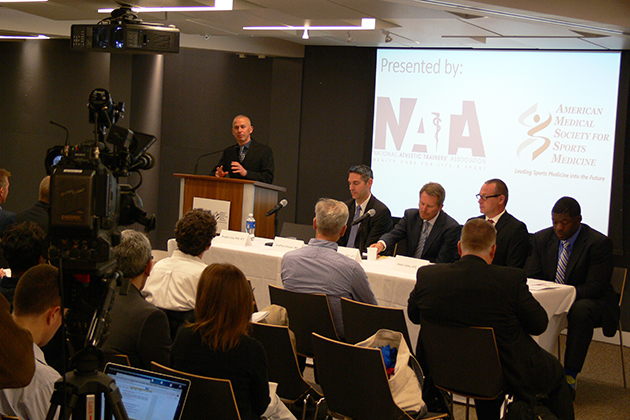
Last year, 15 high school athletes died playing or practicing sports and thousands more suffered injuries, some of them career-ending. Many of those fatalities and long-term injuries could have been averted, say researchers with UConn’s Korey Stringer Institute, if more school systems hired full-time athletic trainers and adopted other important health safety protocols.
On Thursday (March 26), members of the Institute joined leaders from the National Athletic Trainers’ Association (NATA) and the American Medical Society for Sports Medicine (AMSSM) in a “call to action” to promote the need for more athletic trainers and other critical safety measures in high schools across the country.

The groups made their case at a news conference at National Football League headquarters in New York. The NFL is a core sponsor of UConn’s Korey Stringer Institute (KSI), which is dedicated to preventing sudden death in sport due to exertional heat stroke and other catastrophic conditions.
“It is vital for schools to have appropriate sports medicine care during games and practices to ensure the safety of high school student athletes,” says kinesiology professor Douglas Casa, chief operating officer of the KSI and director of athletic training education at UConn. The Korey Stringer Institute is affiliated with the College of Agriculture, Health, and Natural Resources.
The joint news conference was a major milestone for the Korey Stringer Institute, which has been advocating for more full-time athletic trainers and better medical coverage for young athletes since it opened in Storrs in 2010. Casa and the KSI team have been conducting a nationwide education campaign to get states to adopt better health and safety protocols for athletes. Early in the process, Casa helped craft NATA’s landmark position statement on preventing sudden death in secondary school athletics that was endorsed by 16 organizations including AMSSM, which is the national governing body for team physicians, and the National Federation of State High School Associations.
Thursday’s event included a first-ever work session with key stakeholders in high school sports medicine from all 50 states. The group discussed strategies for strengthening medical coverage for student athletes. Casa said future sessions are already planned for 2016 and 2017.
“Adopting these measures and putting them into practice will potentially help save lives and reduce injury,” says Jim Thornton, NATA president. “These recommendations are vital and reinforce our commitment to safety today.”
Currently, only 12 percent of all states require that schools have a detailed emergency action plan in place for critical incidents involving athletes. Only 14 of the 50 states meet minimum best practices in regard to protecting athletes from heat stroke, such as limiting practices on extremely hot days and allowing athletes to gradually adjust to working out in the heat. Half of the states have automated external defibrillators at school-sanctioned athletic events.
The decisions made in the first 10 minutes after a catastrophic incident will often be the difference between life and death. — Doug Casa
On the positive side, access to athletic trainers at high schools has doubled over the past two decades. Currently, about 70 percent of public high schools around the country have athletic training services, compared to about 35 percent in 1994.
“While the percentage of secondary schools with athletic trainer services has increased dramatically, school districts should begin or continue to hire athletic trainers to improve coverage for appropriate care,” says Casa, a competitive-long distance runner and international expert on exertional heat stroke. “The decisions made in the first 10 minutes after a catastrophic incident will often be the difference between life and death.”
Yet schools without athletic trainers continue to rely on coaches, administrators, athletic directors, and others to provide on-site medical care. Only about 37 percent of schools around the country have at least one athletic trainer on staff as a full-time employee, according to a recent study conducted by the KSI in conjunction with NATA.
Riana Pryor, director of research for the KSI, says a reliance on school faculty and other staff to recognize and treat sports injuries and related medical emergencies puts athletes’ lives at risk. Athletic trainers undergo years of training in such areas as athlete conditioning, injury prevention, emergency action planning, and injury treatment before becoming certified in the field, she says. In addition, athletic trainers are taught to identify the symptoms of potentially deadly conditions such as exertional heat stroke, cardiac conditions, and exertional sickling, which is a medical emergency involving reduced blood flow that occurs in athletes carrying the sickle cell trait.
Pryor and her research team at the KSI contacted all 14,951 public secondary schools in the United States as part of their athletic trainer survey. Many schools were contacted multiple times with about 8,500 providing data. The study, published in the February 2014 issue of the Journal of Athletic Training, found that schools with athletic trainer services used them at competitions more than practices. This gap in medical coverage exists despite the fact that many injuries happen during practices where athletes often perform grueling drills and exercise longer than during games.
With an estimated 7 million secondary school students participating in organized sports around the country each year and approximately 1.4 million high school sports injuries reported annually, having proper medical care and monitoring for those students is critical, says Pryor, a certified athletic trainer with a master’s degree in exercise and sports science, who served as the lead author of the study.
“The more athletic trainers we have in our high schools,” Pryor says, “the safer sports practices and games become.”


